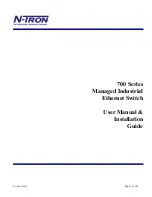
For the multiple PPP sessions, please go to PPP Configuration page (Section 6.3).
•
•
Service Name:
The service name of PPP is required by some ISPs. If the ISP does not provide the Service Name,
please leave it blank.
•
•
Disconnect Timeout:
The Disconnect Timeout allows the user to set the specific period of time to disconnect from the
ISP. The default is 0, which means never disconnect from the ISP.
•
•
MRU:
Maximum Receive Unit indicates the peer of PPP connection the maximum size of the PPP information field this
device can be received. The default value is 1492 and is used in the beginning of the PPP negotiation. In the normal
negotiation, the peer will accept this MRU and will not send packet with information field larger than this value.
•
•
MTU:
Maximum Transmission Unit indicates the network stack of any packet is larger than this value will be fragmented
before the transmission. During the PPP negotiation, the peer of the PPP connection will indicates its MRU and will be
accepted. The actual MTU of the PPP connection will be set to the smaller one of MTU and the peers MRU. The default is
value 1492.
•
•
MSS:
Maximum Segment Size is the largest size of data that TCP will send in a single IP packet. When a connection is
established between a LAN client and a host in the WAN side, the LAN client and the WAN host will indicate their MSS during
the TCP connection handshake. The default value is 1432.
•
•
Automatic Reconnect:
When it is checked, it will maintain the PPP connection all the time. If the ISP shut down the PPP
connection, it will automatically reconnect PPP session.
•
•
Authentication:
When
AUTO
option is chosen, the PAP mode will run first then CHAP.
•
•
Host name:
Required by some ISPs. If the ISP does not provide the Host name, please leave it blank.
IGMP
Summary of Contents for AccessRunner CX82310
Page 19: ......
Page 26: ... Firmware Version This field display the Conexant firm ware vxworks z version number ...
Page 31: ... LAN These fields display the IP address Subnet Mask and MAC address for the LAN interface ...
Page 33: ......
Page 35: ...Per VC Settings ...
Page 41: ......
Page 43: ......
Page 45: ......
Page 49: ...NAPT Static ...
Page 51: ...NAT Static ...
Page 53: ... Public Port This field allows the user to enter the port number of the Public Network ...
Page 55: ......
Page 57: ......
Page 59: ......
Page 65: ... Reset Counters This button allows user to reset the ATM Status counter ...
Page 67: ... Reset Counters This button allows user to reset the TCP Status counter ...
Page 69: ...Routing Table ...
Page 72: ... Aging Timeout This field allows the user to enter the update period for the MAC table ...
Page 76: ......
Page 81: ...2 User The User Password Configuration page allows the user to set the password for the user ...
Page 82: ......
Page 87: ......
Page 89: ... Testing Ethernet LAN Connection This test checks the Ethernet LAN interface connection ...
Page 91: ...The Code Image Update page allows the user to upgrade the image code locally ...
Page 93: ... Clear Log This field allows the user to clear the current contents of the System Log ...
Page 95: ...Initially the wizard starts the Device dialog screen ...
Page 97: ...Figure 2 Device dialog screen ...
Page 99: ...Figure 3 Network dialog screen ...
Page 101: ...Figure 4 Security dialog screen ...
Page 103: ...Figure 5 Advanced dialog screen ...
Page 115: ...To check LEDs light up when you finish connecting two pieces of hardware ...
















































